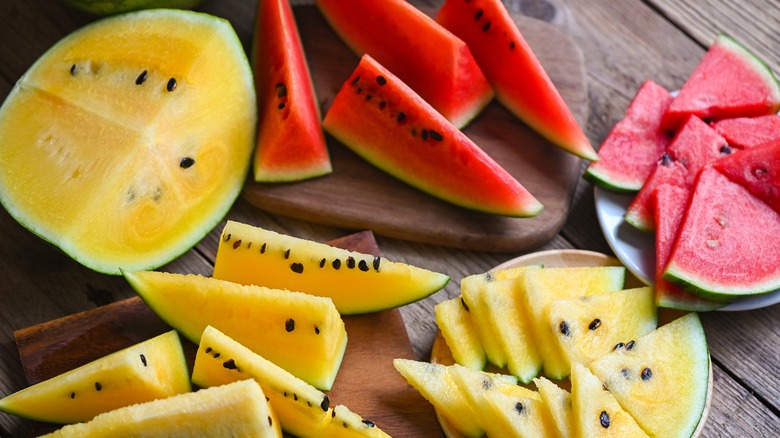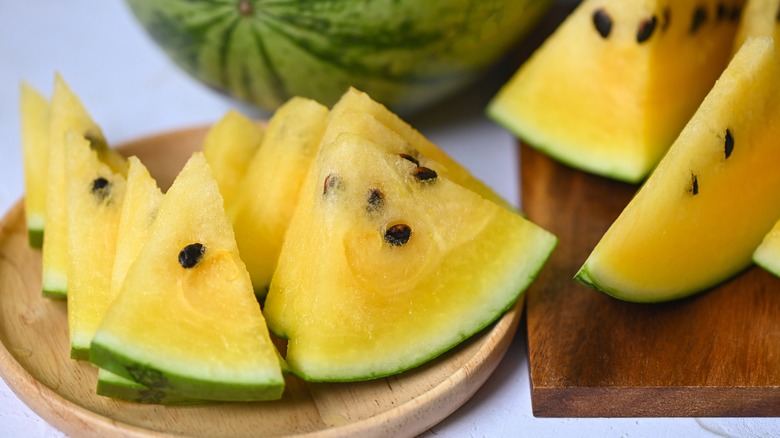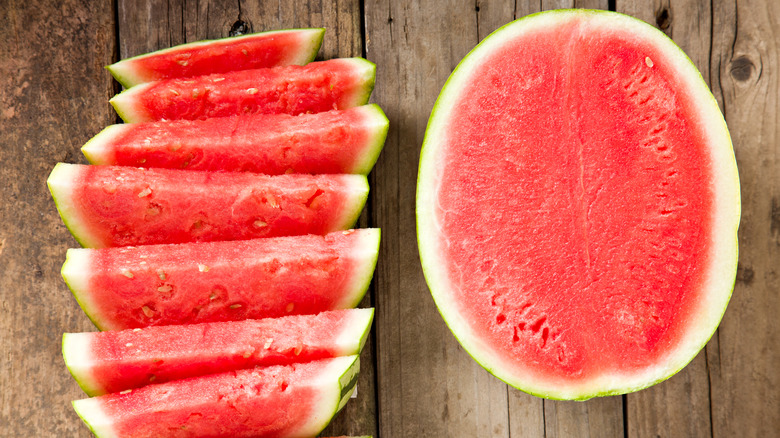The Nutritional Difference In Yellow Vs. Red Watermelon
Watermelon season brings with it watermelons of two vastly different colors. You wouldn't necessarily know it from the outside, though. It's not until you slice open the crisp, hydrating fruit that you'll find different hues inside. One is bright reddish-pink, and the other is vibrant golden yellow. The two types of melons are actually very similar in terms of size, shape, taste, and texture.
Red and yellow watermelon have similar nutritional profiles and benefits as well: Both are composed of over 90% water and are high in vitamins and minerals like vitamin C, vitamin A, fiber, and potassium. However, there is a slight, yet significant, nutritional difference between the two types of watermelon.
It all comes down to the distinct plant pigments present in each type of fruit, which account for their different flesh colors. While an antioxidant and pigment known as beta-carotene gives yellow watermelon its hue, yellow watermelons lack lycopene, the antioxidant responsible for red watermelon's color. The presence or absence of these antioxidants influences the nutritional composition of these two varieties of the juicy, refreshing fruit.
Yellow watermelon and beta-carotene
Beta-carotene is a plant pigment and antioxidant that offers many nutritional benefits. While it's found in many fruits, vegetables, and even herbs and spices, it's generally more concentrated in yellow, golden, orange, or reddish foods like carrots, sweet potatoes, butternut squash, yellow and red peppers, cantaloupe, and, of course, yellow watermelon.
The main nutritional implication of beta-carotene is that it's a source of provitamin A, which means that the body converts this pigment into vitamin A. So, while red watermelon is also a good source of vitamin A, yellow watermelon packs a particularly potent punch of the nutrient. Vitamin A can help support eye health, ensure that your immune system is working properly, and, according to Healthline, it may even protect against certain cancers and diseases.
As an antioxidant, beta-carotene also helps improve cognitive function and prevent oxidative stress in the body, making yellow watermelon not only a sweet, low-calorie snack but also one packed with benefits.
Red watermelon and lycopene
Whereas yellow watermelon is rich in beta-carotene, red watermelon is rich in lycopene, another plant-derived carotenoid antioxidant that comes with its own specific nutritional values. This nutrient is found in other red or pink-colored foods — most notably tomatoes, but also fruits like guava, papaya, and pink grapefruit.
A very strong antioxidant, lycopene also reduces oxidative stress. According to Healthline, it has been linked to protection from not only heart disease, certain cancers, diabetes, and Alzheimer's, but also from environmental toxins such as pesticides and herbicides. It even appears to help the body combat sunburn and defend against damaging UV rays.
In addition to lycopene, red watermelon also contains an amino acid called citrulline. Per Healthline, this amino acid has the potential to enhance athletic performance, mitigate or prevent muscle soreness, and assist in recovery by generating a compound that dilates blood vessels. This dilation makes it easier for the heart to circulate blood throughout the body.



